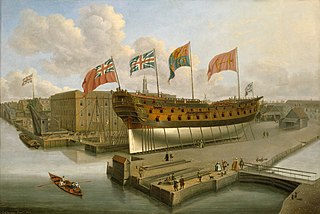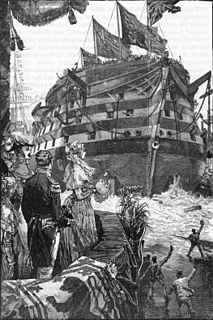Related Research Articles

Woolwich Dockyard was an English naval dockyard along the river Thames at Woolwich in north-west Kent, where many ships were built from the early 16th century until the late 19th century. William Camden called it 'the Mother Dock of all England'. By virtue of the size and quantity of vessels built there, Woolwich Dockyard is described as having been 'among the most important shipyards of seventeenth-century Europe'. During the Age of Sail, the yard continued to be used for shipbuilding and repair work more or less consistently; in the 1830s a specialist factory within the dockyard oversaw the introduction of steam power for ships of the Royal Navy. At its largest extent it filled a 56-acre site north of Woolwich Church Street, between Warspite Road and New Ferry Approach; 19th-century naval vessels were fast outgrowing the yard, however, and it eventually closed in 1869. The former dockyard area is now partly residential, partly industrial, with remnants of its historic past having been restored.

HMS Royal Charles was a 100-gun first-rate ship of the line of the Royal Navy, designed and built by Sir Anthony Deane at Portsmouth Dockyard, where she was launched and completed by his successor as Master Shipwright, Daniel Furzer, in March 1673. She was one of only three Royal Navy ships to be equipped with the Rupertinoe naval gun.

HMS Captain was a 70-gun third rate built at Woolwich Dockyard in 1677/78. After sitting in Ordinary for ten years she was in active commission for the War of the English Succession fighting at Beachy Head and Barfleur. She was in Ordinary until 1706 when she was rebuilt. She was in active commission for the last half of the War of Spanish Succession but fought in no major engagements. She was at the Battle of Passero I 1718. She was rebuilt in 1720/22. She made two forays in to the Baltic though the bulk of her late career was spent as guardship at Portsmouth. She was hulked in 1740 and finally broken in 1762.

HMS Kent was a 70-gun third rate ship of the line built by Sir Henry Johnson of Blackwall in 1677/79. She served during the War of English Succession 1699 to 1697, participating in the Battle of Barfleur. She was rebuilt in 1697/99. She served during the War of Spanish Succession 1702 to 1712 and partook in the Battles of Vigo and Velez-Malaga. She partook in the Battle of Passaro then served during the short war with Spain, December 1718 to February 1720. She was rebuilt in 1722/26. She spent the next thirteen years as a guard ship at Portsmouth. In the 1740s she was off Cape Finisterre then in the West Indies. She returned home and was finally broken in 1744.
HMS Salisbury was a 50-gun fourth rate ship of the line of the Royal Navy, built at Chatham Dockyard to the dimensions of the 1706 Establishment, and launched on 3 July 1707. In autumn of 1707, she brought the body of admiral Sir Cloudesley Shovell from St Mary's to Plymouth prior to his burial in Westminster Abbey.
HMS Falmouth was a 50-gun fourth-rate ship of the line built for the Royal Navy in the first decade of the 18th century. The ship participated in several battles during the War of the Spanish Succession (1701–15) and the War of Jenkins' Ear (1739–48).
The 1719 Establishment was a set of mandatory requirements governing the construction of all Royal Navy warships capable of carrying more than 20 naval long guns. It was designed to bring economies of scale through uniform vessel design, and ensure a degree of certainty about vessel capability once at sea, and was applied to all vessels from the first-rate to the fifth-rate. Once in effect, it superseded the 1706 Establishment, which had specified major dimensions for ships of the second-rate, third-rate and fourth-rate only.
Benjamin Rosewell (c.1665–1737) was a master shipwright at Harwich, Plymouth, Chatham and Sheerness Naval Dockyards, and Governor of Hawkins Hospital, Chatham.
HMS Solebay was a member of the Gibraltar Group of 24-gun sixth rates. After commissioning she spent her career in Home waters, North America, and the West Indies on trade protection duties. She was converted to a bomb ketch with 3 mortars and six guns in 1726. She became a fireship in 1734 then converted back to a 24-gun sixth rate in 1735. Her final conversion was into a hospital ship to lie at Tower Wharf in 1742. She was sold in 1748.
HMS Rose was a member of the Gibraltar Group of 24-gun sixth rates. After commissioning she spent her career in Home waters and North America on trade protection duties. She was rebuilt at Woolwich between 1722 and 1724. After her rebuild she served in Home Waters, North America, West Indies and the Mediterranean on trade protection. She was sold in 1744.
HMS Lowestoffe was a 32-gun fifth rate built at Chatham Dockyard in 1696/97. She spent her career on counter piracy patrols and trade Protection duties. She participated in the capture of Port Royal in Nova Scotia. She was rebuilt in 1722/24 as a 20-gun sixth rate. She was sold in July 1744.
Thomas Bucknall (c.1705–c.1775) was an 18th-century Royal Navy shipbuilder based alternatively at Plymouth and Portsmouth.

Richard Stacey (1663–1743) was an English shipbuilder and ship designer employed by the Royal Navy at several dockyards but predominantly Deptford.

Sir Jacob Ackworth or Acworth (1668–1748) was an English shipbuilder and ship designer employed by the Royal Navy. As a designer he adopted Newtonian theories to create lighter and faster ships but this approach marginalised him with the very traditional dockyards and he spent his final years on the Navy Board as an advisor.
Israel Pownoll (c.1710–1779) was an English shipbuilder for the Royal Navy.
Peirson Lock (c.1690–1755) was a shipbuilder and designer for the Royal Navy who was Master Shipwright of Plymouth Dockyard from 1726 to 1742, and of Portsmouth Dockyard from 1742 to 1755.

Joseph Allin was an 18th century shipbuilder to the Royal Navy. His works merge with those of his namesake son who was also a Master Shipwright at Portsmouth Dockyard and later Surveyor to the Navy at which point he became Sir Joseph Allin.

Edward Allin (c.1720–1795) was an 18th century shipbuilder to the Royal Navy mainly based at Portsmouth Dockyard and Chatham Dockyard. He is most notable as the master shipwright of HMS Victory Nelson's flagship.

Sir William Rule (c.1750–1816) was a shipbuilder and designer to the Royal Navy who rose to be Surveyor of the Navy.